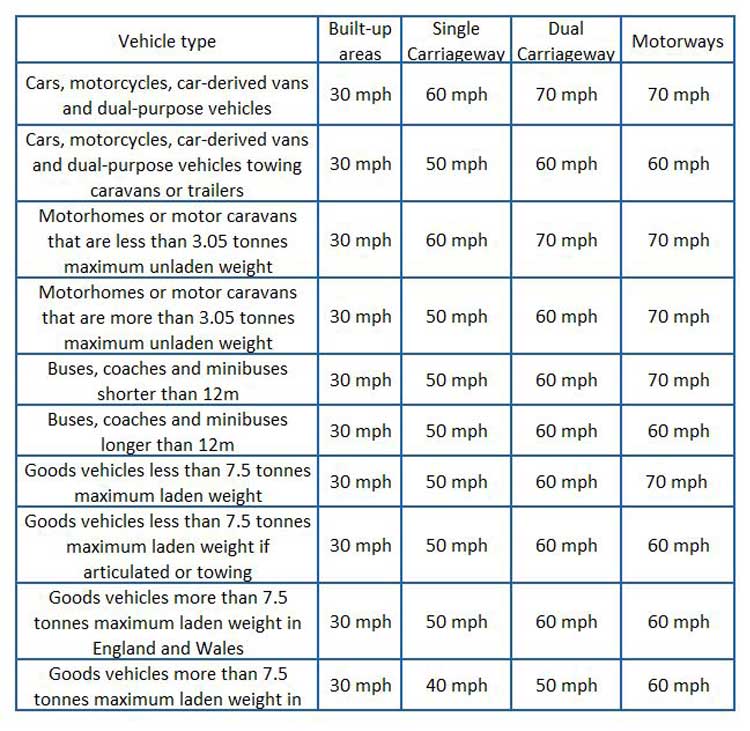February 27, 2023
Abby Nuttall
Articles
One of the main areas of concern that fleet managers have when it comes to their drivers is speeding.
Speeding puts your drivers, their passengers and other road users at greater risk of harm of injury and even fatality. As an employer, your company has a duty of care to make sure your staff is safe while at work, and this includes in company-provided equipment such as a company car. Whilst you aren’t able to stop your drivers from speeding you can ensure you do as much as possible to make sure they understand the impact of speeding, any speed restrictions on their vehicles and how to stop themselves from exceeding limits.
Know Your Limits
In the UK there are various speed limits depending on the type of road, where it’s located and what type of vehicle you are driving. We think it’s important that as a fleet manager you understand what these limits are and when they apply, not only to keep yourself on the road but so that you can help your drivers understand and comply with them.
The table below shows the speed limit for different types of roads based on the type of vehicle being driven. Please note this is the national speed limit and the speed limit on individual roads may be lower than this.

As you can see there are particular types of vehicles that cannot go as fast as the national limit, this is due to their size and weight and their limits are based on what is a safe speed for them to travel. If your drivers are required to tow, drive goods vehicles or buses then you should know these limits and make sure your drivers do too, as they will not be signposted.
Top Tips for Reducing Fleet Speeding
There are a few best practices that we recommend for reducing speeding in your fleet and these are the five that we’ve found work the best.
1. Increase Driver Training
Provide your drivers with additional training, focused on speed limit awareness, the consequences of speeding and strategies to help them keep to the speed limit. This can be in the form of one-on-one meetings with the fleet management team, a formal group class or virtual training.
As well as training we also recommend providing your drivers with supporting documents that are available for them to access with key information. This can be in the form of a regular email flyer to your internal directory, a PDF on a shared drive or a handout they keep in the car.
2. Use Telematics
We think telematics are a key part of fleet management for a number of reasons, one of which is that you can monitor fleet journeys and highlight areas of concern, for example, if one driver or vehicle is often travelling at high speeds. Telematics are a great tool in helping you identify problems like this that you can then find a solution to.
3. Invest in Route Planning
Another way that you can use telematics to support your drivers and help reduce the probability of speeding is by investing in route planning, which allows enough time for them to drive at a safe and legal speed. GPS systems that have up to date traffic information can also assist, as not only does the driver have an accurate route to follow but they have a realistic eta that they can communicate if there is a delay.
Your drivers having a planned route with accurate timeframes reduces the likelihood of them feeling time pressured and thinking that they need to speed to make up the time.
There are other benefits to effective route planning as well, including:
- Improved fuel efficiency and reduced fuel usage
- Potentially reduced driver time on the roads
- Spotting opportunities for car sharing
- Planning routes with convenient fuel / charging stops
4. Monitor Driving Licence Checks
Part of fleet management involves checking that your drivers hold valid driving licences for the vehicles you are giving them to drive, or that you require them to drive as part of their role. Regular checks will keep you updated on any changes to their driving licence entitlements and any endorsements, including those for speeding. Knowing that a driver has a speeding endorsement means that you can then provide them with additional support in this area.
5. Have a Speed Awareness Campaign
Another strategy that you can add to your existing fleet maintenance programme is to have a speed awareness campaign. This would be in addition to the training you already offer drivers and can be completely tailored to your company and drivers.
A few aspects we would recommend including in a campaign are:
The speed limits – making sure to highlight different limits for different vehicles if you know there are drivers who drive a minibus, use trailers or tow caravans.
The costs of speeding for the driver – financially, points on licence and how it could impact their ability to do their job.
Ways in which drivers can reduce their speeding – using features like cruise control, reducing stress before and during driving and accessing free tools and support available to them.
How the business is helping drivers reduce their speeding – highlighting support and training that’s available, route planning and other services they can access.
Enjoyed this article? Read more of our latest blogs below:
- The Top Five Saloon Cars of 2023
- The Most and Lease Loved EVs in the UK
- Understanding the Different Driving Licence Categories
- How to Prepare Your Company Car for Return
Want to know more about fleet vehicles?
For all our latest news and blogs click HERE.
Or are you looking to understand the company car, fleet management or any other aspect of fleet vehicles? If so, then check out our Guide Pages.
